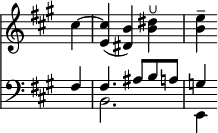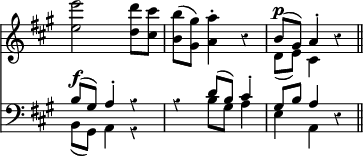the strongest beat of all when the bars are thrown into groups by the rapidity of the time of the movement. So that the cadence proceeds from a chord without emphasis to a chord with it, or in other words, from the unaccented to the accented part of the bar; as first—

from Mozart's Quartet in A, No. 5; or—

from his Quartet in E♭, No. 4.
The next commonest position is to find the final chord in the middle of a bar which is equally divisible into two halves, as on the third beat of a bar of four, and the fourth of a bar of six. Of both of these Mozart makes very frequent use—as in the first movement of the first Quartet, the slow movement of the Quartet in B♭, the Rondo for pianoforte in A, and the Variations in the Sonata in A. Very often he seems to use this position with a sense of its being weaker and less conclusive than that in which the last chord falls on the first beat of a bar, and hence as a kind of pseudo-imperfect cadence; as in the slow movement of the Quartet in D minor, No. 2, which begins thus—

Cadences are also, but far more rarely, found occupying reversed positions, as in polonaises, where the last chord of a cadence, owing to the peculiar rhythmic character of the movement, frequently falls on the last beat of a bar of three; as in Chopin's Polonaise in C♯ minor—
![{ \override Score.TimeSignature #'stencil = ##f \time 6/8 \key des \major << << \relative a' { aes16[ r32 a bes16 c] ees4 des8 r } \\ \relative g' { <ges c,>8 s r <aes ges> f } >>
\new Staff { \clef bass \key des \major \relative a,, { aes8 <aes'' ees'> r <aes c> <des des,> r } } >> }](http://upload.wikimedia.org/score/b/k/bk6700p6iyn59t8n1rvfjoc8ffpq6ot/bk6700p6.png)
In Mozart's Rondeau en Polonaise, from the Sonata in D, the cadences fall on the second beat, as in
![{ \override Score.TimeSignature #'stencil = ##f \key a \major \override Score.Rest #'style = #'classical \time 3/4 << \relative a' { a16\p b\cresc cis d e fis gis a gis fis e d | cis\f e d b << { <b d,>4 <a cis,> \bar "||" } \\ { e2 } >> }
\new Staff { \clef bass \key a \major \relative a { r4 <a e cis> <a d,> | << { a8[ gis] } \\ { e4 } >> a8 e a,4 } } >> }](http://upload.wikimedia.org/score/r/5/r53kxethvh4sc2lg6sv794rahvydry2/r53kxeth.png)
where the B and D are merely suspensions of the final chord of A—and in Beethoven's Quartet in A minor, op. 132, the last chord of the cadences in the movement 'Allegro ma non tanto,' falls on the second beat of a bar of three—

and in the slow movement of his Quartet in B♭, op. 130, at the end, the last chord falls on the last beat of a bar of four—
![{ \override Score.TimeSignature #'stencil = ##f \time 4/4 \key des \major << \relative c''' { << { c8[ des] aes[ bes] aes,16[ r c] } \\ { ges8:32[ f8:32] ees32[ ees des des] des[ des <ees des> <ees des>] <f des>16[ r g] } >> r16\fermata \grace { aes,16[( <des f> aes')] } <f des'>8 r \bar "||" }
\new Staff { \clef bass \key des \major \relative e { << { ees8:32[ des8:32] s4. ees16 s des8 r } \\ { aes8:32[ bes8:32] <c ees>32[ <c ees> <des f> <des f>] <ees g,>[ <ees g,> g, g] aes16[ r aes] r_\fermata \grace { des,16[ aes' f'] } des,8 } >> } } >> }](http://upload.wikimedia.org/score/l/5/l59a8qpmwvoyk2grkenh4g0n7bv70sb/l59a8qpm.png)
so that in point of fact the greatest authorities may be quoted to justify cadences in almost any position in the bar; but the last-mentioned instances are decidedly exceptional, and can only be justifiable when the movement in which they are used has some very marked peculiarities of rhythm or a very strong emotional character.
CADENZA in its simplest acceptation is a flourish of indefinite form, introduced upon a bass note immediately preceding a close of some finality; that is, occupying the position of full stop either to an entire movement, or to an important section of one. The custom was most probably originated by singers, who seized the opportunity afforded by the chord of 6–4 on the dominant immediately preceding the final close of an aria or scena, to show off the flexibility, compass, and expressive powers of their voices to the highest advantage; so that the piece coming to an end immediately afterwards, the audience might have the impression of astonishment fresh in their minds to urge them to applause.
The idea thus originated spread widely to all kinds of music, and in course of time its character has changed considerably, though the flourish of which it is composed is still its
